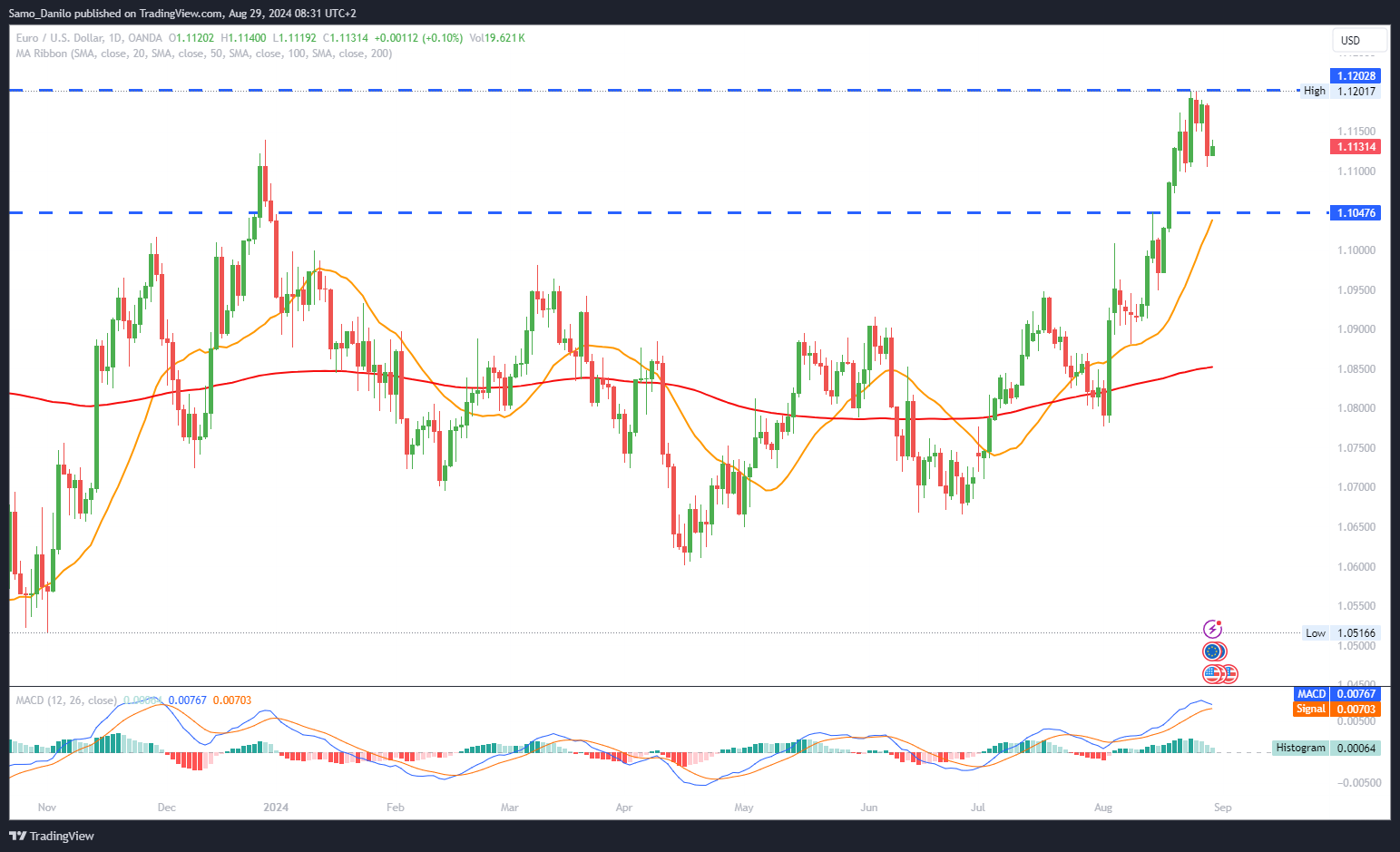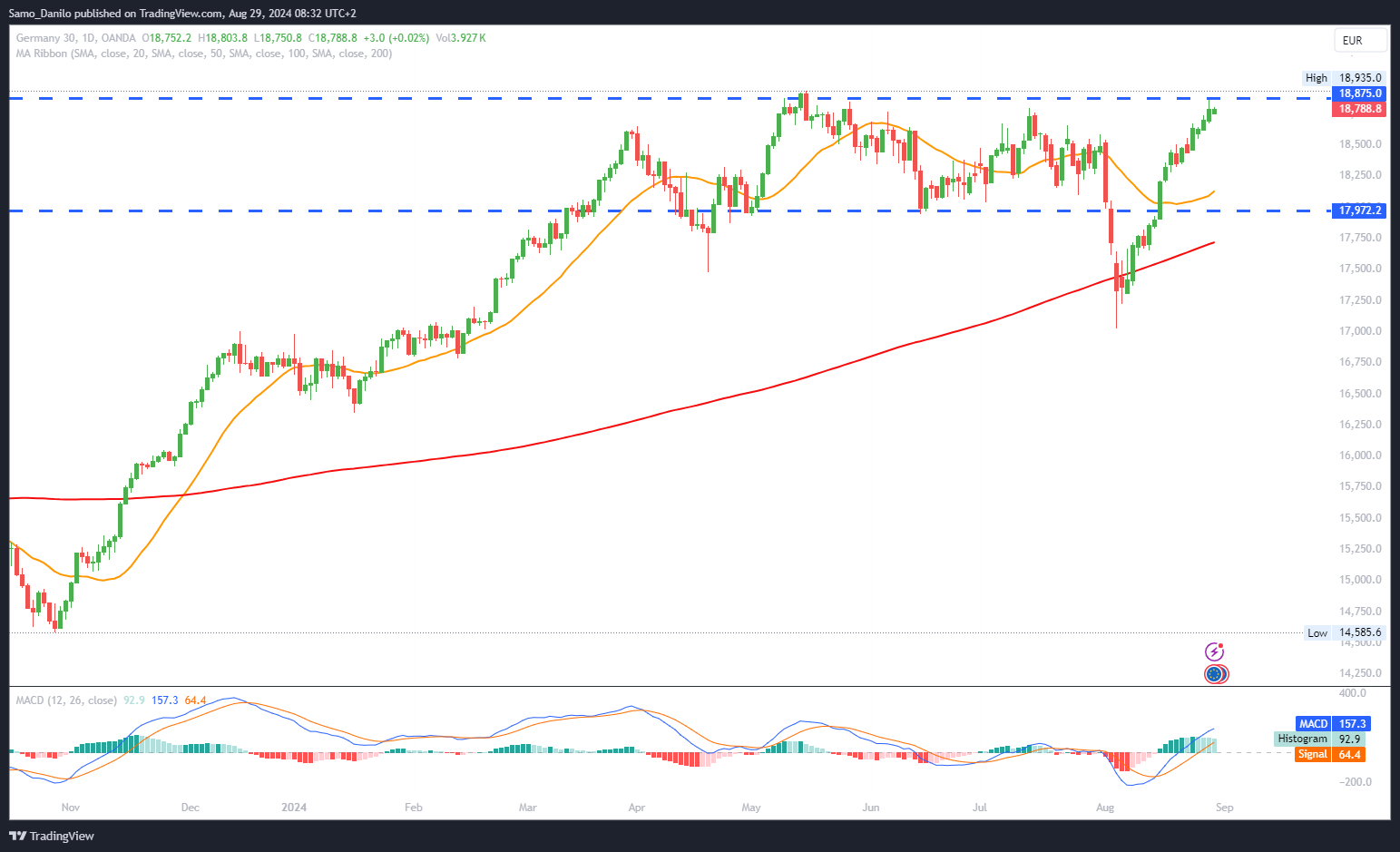EURUSD
- EUR/USD Recovery: The EUR/USD pair is back in the green early Thursday, reversing some of the losses seen during Wednesday’s steep sell-off. The recovery suggests that buyers are stepping back in as the market digests recent moves.
- Technical Outlook: From a short-term technical perspective, the uptrend for EUR/USD remains intact as long as the pair holds above the key support level of 1.1107. This support level is crucial for maintaining the bullish outlook in the near term.
- Market Sentiment: Markets are trading cautiously following a disappointing sales forecast from the American AI giant, Nvidia. This forecast has injected a dose of nervousness into market sentiment, especially with key economic data releases looming.
- Key Economic Data: Germany is set to publish its preliminary inflation data, which will be closely watched for any signs of easing or persistent inflationary pressures in the Eurozone's largest economy. On the US side, the calendar will feature the second estimate of the Gross Domestic Product (GDP) for Q2 2024 later Thursday, providing insight into the US economic trajectory.
- Upcoming Events: Looking ahead to Friday, the data docket includes the pan-EU Harmonized Index of Consumer Prices (HICP) inflation print, expected early in the European session. Later, the US Personal Consumption Expenditure Price Index (PCE) inflation will be released, which is a key inflation gauge for the Federal Reserve.
Closing statement: The EUR/USD pair has shown resilience after recent declines, and the uptrend remains intact above the 1.1107 support level. However, the direction in the near term will likely be influenced by upcoming economic data from both Germany and the US. If the data supports a continuation of current trends, the pair could continue its upward trajectory, but downside risks remain if the figures disappoint, particularly considering cautious market sentiment.
GBPUSD
- GBP/USD Rebound: The GBP/USD pair is making a strong push back toward the 29-month high set on Tuesday at 1.3266. The ongoing recovery signals continued bullish momentum as the pair approaches this key resistance level.
- Recent Performance: Analysing the daily chart, GBP/USD has been on a remarkable bullish streak over the last three weeks. The pair has rallied from below 1.27 earlier in the month to trade above 1.32 at present, marking a gain of over 500 pips. The pair has seen positive movement in 13 of the last 15 trading days, reflecting strong upward pressure.
- Monetary Policy Divergence: The divergent outlooks between the US Federal Reserve (Fed) and the Bank of England (BoE) continue to favour the GBP/USD uptrend. While the Fed has signalled a potential shift towards rate cuts, the BoE's more hawkish stance has supported the pound, driving the pair higher.
- Labour Market Focus: Traders remain focused on the labour market's condition, which is increasingly becoming a focal point for the Fed. The central bank has explicitly emphasized its attention on employment trends, making labour market data particularly impactful on market movements in the current environment.
- Key Data and Technical Levels: The further upside in GBP/USD will be closely tied to the upcoming release of the second estimate of the US Q2 Gross Domestic Product (GDP). Additionally, traders are watching the pair’s ability to maintain acceptance above the 21-Simple Moving Average (SMA) on the four-hour chart, which could provide additional confirmation of the bullish trend.
| SMA (20) | Rising |
|
|
| RSI (14) | Rising |
|
|
| MACD (12, 26, 9) | Rising |
|
|
Closing statement: GBP/USD continues to exhibit strong bullish momentum, with the potential to retest and possibly surpass the recent high of 1.3266. The pair’s direction will largely depend on upcoming US economic data, particularly the Q2 GDP estimate. If the data supports a continuation of the current trends, and the pair remains above the 21-SMA, further gains are likely. However, any negative surprises could trigger a correction in the short term.
GOLD
- Gold Price Recovery: Gold is attempting a modest recovery, holding above the crucial $2,500 level early Thursday. The precious metal remains within this week’s familiar trading range, as market participants weigh various economic and financial factors.
- Nvidia Earnings Impact: Traders are closely analyzing the implications of Nvidia’s earnings report. Despite a remarkable 122% revenue growth and a massive $50 billion stock buyback, Nvidia’s shares dropped 7% in post-market trading due to a sales forecast that fell short of high market expectations. The broader market sentiment, affected by such significant earnings reports, can have indirect effects on safe-haven assets like gold.
- Fed Commentary: Early Thursday, Atlanta Fed Chair Raphael Bostic expressed skepticism about an imminent interest rate cut, suggesting that inflation has decreased faster than anticipated, and unemployment has risen more than expected. His comments could temper expectations for aggressive monetary easing, which in turn influences gold prices.
- US Dollar and Bond Yields: A broad-based retreat in the US Dollar, coupled with a decline in US Treasury bond yields, has provided additional support for gold prices. These factors are crucial as they lower the opportunity cost of holding non-yielding assets like gold.
- Fed Rate Cut Expectations: Market participants are currently pricing in a 65% probability of a 25-basis point rate cut by the Federal Reserve in September, with a 35% chance of a more aggressive 50-basis point cut. These expectations, reflected in the CME Group’s FedWatch Tool, are pivotal in driving gold price movements as they signal the Fed’s future monetary policy stance.
| SMA (20) | Rising |
|
|
| RSI (14) | Rising |
|
|
| MACD (12, 26, 9) | Rising |
|
|
Closing statement: Gold prices remain well-supported above $2,500, with a modest recovery in progress. The precious metal’s direction will likely hinge on upcoming US economic data, including the second estimate of Q2 GDP, and further signals from the Fed regarding rate cuts. A continued retreat in the US Dollar and bond yields could sustain the upward momentum, pushing gold toward the higher end of its current range. Conversely, any hawkish surprises from the Fed or stronger-than-expected economic data could cap gains and trigger a pullback.
CRUDE OIL
- WTI Price Movement: West Texas Intermediate (WTI), the US crude oil benchmark, is trading around $74.60 on Thursday. The recent dip in prices reflects market concerns over global economic health and demand dynamics, particularly in China.
- China’s Economic Slowdown: The ongoing economic slowdown in China, the world’s largest oil importer, is fueling fears about future oil demand. Sluggish economic activity and reduced industrial output in China are exerting downward pressure on WTI prices, as traders worry about weakening consumption in one of the key markets.
- US Crude Oil Stockpiles: Data from the Energy Information Administration (EIA) revealed a modest decline in US crude oil inventories, with stockpiles falling by 0.846 million barrels to 425.2 million barrels for the week ending August 23. While this decrease suggests some tightening in the US market, it has not been enough to offset broader demand concerns.
- Libyan Oil Disruptions: UBS analyst Giovanni Staunovo commented that the disruptions in Libya, where political unrest threatens oil production, could tighten the global oil market. However, the impact on prices is contingent on a significant reduction in Libyan crude exports, which has yet to materialize fully.
- OPEC+ Speculation: Speculation is growing that OPEC+ might increase oil production to suppress prices, potentially targeting higher-cost producers like US shale companies. This strategic move could add further pressure on WTI prices, as an increase in global supply could outpace demand, especially if economic conditions remain weak.
| SMA (20) | Falling |
|
|
| RSI (14) | Slightly Rising |
| |
| MACD (12, 26, 9) | Slightly Falling |
|
Closing statement: WTI prices are under pressure, trading around $74.60, with downside risks driven by concerns over China’s economic slowdown and potential increases in global oil supply. The market is closely watching developments in Libya and any signals from OPEC+ regarding production adjustments. If Libyan disruptions reduce global supply or if OPEC+ refrains from increasing output, WTI could find some support. However, without clear bullish catalysts, the price may struggle to rise significantly and could remain vulnerable to further declines.
DAX
- Market Movers: The DAX climbed to its highest close since May, driven by gains in the insurance and chemical sectors. These sectors outperformed amid broader market strength. However, the auto sector lagged, limiting the overall gains, as disappointing EU car sales figures for July weighed on investor sentiment. The weak performance in auto stocks reflected concerns about demand and potential challenges facing the industry in the near term.
- NVIDIA Earnings Impact: After the US markets closed, NVIDIA released its earnings report, which exceeded Wall Street expectations but fell short of the highest estimates. In response, NVIDIA shares dropped by 6.89% in after-hours trading. This decline could influence tech sentiment globally, including in European markets, and may weigh on DAX-listed tech stocks as investors digest the implications.
- German Inflation Figures: On Thursday, investors will closely watch the release of Germany's inflation figures. Economists expect the annual inflation rate to decrease from 2.3% in July to 2.1% in August. Softer-than-expected inflation could heighten speculation about a potential rate cut by the European Central Bank (ECB) in September, influencing market sentiment and possibly supporting DAX gains.
- ECB Chief Economist Speech: ECB Chief Economist Philip Lane is scheduled to speak on Thursday. His views on inflation, economic conditions, and the potential timeline for an ECB rate cut will be critical. Investors will scrutinize his comments for any signals that could suggest a shift in ECB policy, which would impact on the DAX and broader European markets.
- US Economic Data: Also on Thursday, several key US economic data points, including GDP, housing sector statistics, and labor market data, will be released. While a significant revision to the GDP figure could stir markets, weekly jobless claims are expected to have a more direct impact on market risk sentiment. Strong US labor market data could influence global markets, including the DAX, as it could sway expectations regarding the US Federal Reserve's monetary policy.
| SMA (20) | Slightly Falling |
| |
| RSI (14) | Rising |
|
|
| MACD (12, 26, 9) | Rising |
|
|
Closing statement: The DAX is poised to react to multiple factors on Thursday, including German inflation data, ECB commentary, and key US economic releases. A softer inflation print in Germany could bolster hopes for an ECB rate cut, supporting further gains. However, weakness in the auto sector and tech stock performance, influenced by NVIDIA’s earnings, could limit upside momentum. The market will also be sensitive to US economic data, particularly any surprises in labour market figures that might shift global risk sentiment.




